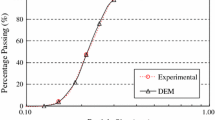Abstract
The fabric anisotropy of a granular soil deposit can strongly influence its engineering properties and behavior. This paper presents the results of a novel experimental study designed to examine the effects of fabric anisotropy on smallstrain stiffness and its evolution with loading on the elastic shear modulus of granular materials under a K 0 condition. Two primary categories of fabric anisotropy, i.e., deposition-induced and particle shape-induced, are investigated. Toyoura sand deposits with relative densities of 40% and 80% were prepared using deposition angles oriented at 0° and 90°. Piezoelectric transducers were used to obtain the elastic shear modulus in the vertical and horizontal directions (G vh and G hh). The measurements indicate distinct differences in the values of G with respect to the different deposition angles. Particle shapeinduced fabric anisotropy was examined using four selected sands. It was concluded that sphericity is a controlling factor dominating the small-strain stiffness of granular materials. The degree of fabric anisotropy proves to be a good indicatorin the characterization of stress-induced fabric evolution during loading and unloading stress cycles. The experimental data were used to calibrate an existing micromechanical model, which was able to represent the behavior of the granular material and the degree of fabric anisotropy reasonably well.
Similar content being viewed by others
References
Ashamawy AK, Sukumaran B and Vinh Hoang V (2003), “Evaluating the Influence of Particle Shape on Liquefaction Behavior Using Discrete Element Method,” Proc. 13th Int. Offshore and Polar Engineering Conf., ISOPE, Honolulu, 2: 542–549.
Bellotti R, Jamiolkowski M, Lo Presti DCF and O’Neill DA (1996), “Anisotropy of Small Strain Stiffness in Ticino Sand,” Geotechnique, 46(1): 115–131.
Bowman ET, Soga K and Drummnond W (2001), “Particle Shape Characterization Using Fourier Descriptor Analysis,” Geotechnique, 51(6): 545–554.
Casagrande A and Carillo N (1944), “Shear Failure of Anisotropic Material,” Proc. Boston Society of Civil Engineering, 31: 74–83.
Cho G, Dodds J and Santamarina JC (2006), “Particle Shape Effects on Packing Density, Stiffness and Strength: Natural and Crushed Sands,” Journal of Geotechnical and Geoenvironmental Engineering, ASCE, 132(5): 591–602
Cubrinovski M and Ishihara K (2002), “Maximum and Minimum Void Ratio Characteristics of Sands,” Soils and Foundations, 42(6): 65–78.
Cui L and O’Sullivan C (2006), “Exploring the Macro- and Micro-scale Response of an Idealized Granular Material in the Direct Shear Apparatus,” Geotechnique, 56(7): 455–468.
Dyvik R and Madshus C (1985), “Lab Measurements of G max Using Bender Elements,” Advances in the Art of Testing Soils Under Cyclic Conditions, Conference, Detroit, MI, Geotechnical Engineering Division, ASCE, 186–196.
Guo PJ (2008), “Modified Direct Shear Test for Anisotropic Strength of Sand,” Journal of Geotechnical and Geoenvironmental Engineering, ASCE, 134(9): 1311–1318.
Hardin BO (1980), “Discussion of Anisotropic Shear Modulus due to Stress Anisotropy,” Journal of Geotechnical Engineering Division, ASCE, 106(8): 956–958.
Hardin BO and Blandford GE (1989), “Elasticity of Particulate Materials,” Journal of Geotechnical Engineering, ASCE, 115(6): 788–805.
Hryciw RD and Thomann TG (1993), “Stress-history -based Model for Ge of Cohesionless Soils,” Journal of Geotechnical Engineering, ASCE, 15(6): 1073–1093.
Kuwano R and Jardine RJ (2002), “On the Applicability of Cross-anisotropic Elasticity to Granular Material at Very Small Strain,” Geotechnique, 52(10): 727–749.
Lee CJ and Huang HY (2007), “Wave Velocities and Their Relation to Fabric Evolution during the Shearing of Sand,” Soil Dynamics and Earthquake Engineering, 27(1): 1–13.
Li B, Zeng X and Min H (2010), “Seismic Responses of a Retaining Wall with Anisotropic Backfill,” Proceeding of Earth Retention 2010, Seattle, USA, 688–696.
Li B, Zeng X and Yu H (2014) “Characterization of Liquefaction Resistance of Sand: Effect of Initial Fabirc,” Journal of Earthquake and Tsunami (Online already)
Oda M (1972), “Initial Fabrics and Their Relation to Mechanical Properties of Granular Material,” Soil and Foundations, 12(1): 17–36.
Saada AS (1993), “Elasticity: Theory and Application,” Krieger Publishing Company, Malabar, Florida.
Santamarina JC and Cho GC (2004), “Soil Behavior: the Role of Particle Shape,” Advances in Geotechnical Gngineering: the Skempton Conference, R. J. Jardine, D. M. Potts, and K. G. Higgins, eds., 1: Thomas Telford, London, 604–617.
Yamashita S, Hori T and Suzuki T (2003), “Effects of Initial and Induced Anisotropy on Initial Stiffness of Sand by Triaxial and Bender Elements Tests,” Geomechanics 2003, ASCE, 213–222.
Yimsiri S and Soga K (2000), “Micromechanics-based Stress-strain Behavior of Soils and Small Strains,” Geotechnique, 50(5): 559–571.
Zeng X and Ni B (1997), “Application of Bender Elements in Measuring G max of Sand under K 0 Condition,” Geotechnical Testing Journal, 21(3): 251–263.
Zeng X and Ni B (1999), “Stress Induced Anisotropic G max of Sands and Its Measurement,” Journal of Geotechnical and Geoenvironmental Engineering, ASCE, 125(9): 741–749.
Author information
Authors and Affiliations
Corresponding author
Additional information
Supported by: National Science Foundation of China under Grant No. 41202186 and the Zhejiang National Science Foundation under Grant No. LQ12E08007
Rights and permissions
About this article
Cite this article
Li, B., Zeng, X. Effects of fabric anisotropy on elastic shear modulus of granular soils. Earthq. Eng. Eng. Vib. 13, 269–278 (2014). https://doi.org/10.1007/s11803-014-0229-x
Received:
Accepted:
Published:
Issue Date:
DOI: https://doi.org/10.1007/s11803-014-0229-x




